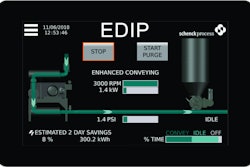
Vice President of Sales and Marketing for Due North Randy Skyba and I sat down and talked about the merchandizing strategies behind fresh pet food from the equipment side. We also discussed the evolution of fresh pet food availability and demand, as well as where the segment might be headed, so tune in for Randy's perspective!
The below transcript is from Episode 21 of the Trending: Pet Food podcast, where I spoke with Vice President of Sales and Marketing for Due North Randy Skyba about fresh pet food merchandizing strategies. You can find the episode at www.PetfoodIndustry.com/trending-pet-food-podcast, on SoundCloud or on your favorite podcast platform. This episode originally aired on November 9, 2022.
Lindsay Beaton – Editor, Petfood Industry magazine and Host, Trending: Pet Food podcast
Hello and welcome to Trending: Pet Food, the industry podcast where we cover all the latest hot topics and trends in pet food. I'm your host and Editor of Petfood Industry magazine, Lindsay Beaton, and I'm here today with Vice President of Sales and Marketing for Due North, formerly known as Minus Forty, Randy Skyba. Hi, Randy, and welcome!
Randy Skyba – Vice President of Sales and Marketing, Due North
Hey, Lindsay. Thanks for having me on today.
Beaton: In case you've not had the opportunity to meet Randy, here's what you need to know about him. He works to ensure that Due North's refrigerated and frozen technology products create a unique, comprehensive merchandizing package for clients' specific needs. He has extensive experience in general management, sales, marketing and strategic planning.
Due North's North American-made freezers provide superior pet food product presentation, deliver a lower total cost of ownership, allow for exceptional product quality, integrity and a hassle-free ownership experience.
Randy's experience in sales and marketing as well as strategy in the fresh/frozen pet food space make him the perfect person to help me answer today's question: What are the keys to a successful fresh pet food merchandizing strategy?
Randy, I want to start out our conversation by talking about some of the differences between merchandizing fresh pet food and other types of pet food. So what are some of those differences?
Skyba: General merchandizing principles apply to both. You have your product well-faced in a location that provides good visibility and consumer access. Due to space constraints and merchandizing pet food in a freezer cooler retailers need to ensure they maximize refrigerated space through well-thought-out planograms and positioning their products at eye level. It's retail fundamentals, but they apply whether that pet food is on a rack, shelf, kibble form, or it's in a freezer or cooler on a shelf. It's still the same principles of facing and merchandizing.
Beaton: Are there some limitations because of the extra equipment you need for fresh pet food? Like do retailers tend to have freezer space in the same parts of their store? Or does that vary from store to store depending on how they're wired and where their refrigeration capabilities are?
Skyba: Well, I definitely think there's a variety based on the location. Every store has a different layout. Obviously, when we're installing freezers, customers have to address the electrical requirements, and that can be a limiting factor sometimes the more you have closer to the front doors, and to get the attention of a consumer as they walk in. However, the reality is many retailers end up putting our units, or any freezer or cooler, along a wall just from an electrical standpoint; it poses an easier installation.
Beaton: Obviously, the visual component of pet food is sort of an inherent marketing strategy, right? That's the thing that customers see when they get in, everybody knows that packaging visibility is one of the most overt ways to get your product merchandized and seen. What would you say is the top challenge in coming up with a successful fresh food merchandising strategy? And given that it needs to be in a cooler, and it really depends a lot on the limitations of positioning with the retailer and what their electricity capabilities are set up as and just the way that their layout is, where does the responsibility for success lie? Is it really more of a partnership between the pet food manufacturer and the retailer than maybe for some other types of pet food? What is that conversation like?
Skyba: Lindsay, today's pet food market retailers have so many options for fresh pet food. Market demand has led to the category of fresh pet food experiencing explosive growth over the recent years. And with this level of growth comes new players, innovative new products. The success of the category really involves all parties: The food manufacturer, food distributor, retailers and refrigeration companies like Due North. Ultimately, the consumer will determine the continued success of the category.
And this will be achieved through the efforts of the food manufacturers developing a healthy option, distributors providing a strong delivery model that ensures the product availability, and the retailer merchandizing the products effectively in glass door merchandizers that provide a positive visual experience and easy access to the food. We see in many retailers [that] they're using glass door freezers like Due North products, or they're sometimes using chest freezers or a solid white door freezer. Consumers are very reluctant to walk up to a storage merchandizer freezer that they can't see what's inside. So visually, you have to see that product. It's the same reason every retailer has impulse items at the checkout: When we see it, we react to it. We can't see it, we tend to walk by it not wanting to question what's inside that.
So really, when you look at the whole strategy it's going to be everybody together making sure that the manufacturers have that packaging nailed down, cosmetically eye-appealing, eye-catching for the consumer. It's making sure that distributors, once again, have that product available and can get it to the store so that the shelves are full. And then the retailer making sure that they have their freezers positioned in the store in such a way that it enhances and encourages the consumer to visit the area. Most successful stores we see the success comes from the retail staff, them and their knowledge of fresh pet food and their belief in the product, and how they promote that to the consumer.
Beaton: And where do you come into the conversation? Do you work more with the manufacturers as part of their merchandizing strategy? And then you come to the retailers together and say, "This is how we would like to present this product?" Or are you more on the retailer side? They're purchasing the freezers from you and you try to help them figure out how to best visualize? Who gets the different weight distribution in that conversation, and where do equipment suppliers like you come into that conversation?
Skyba: That's a good question. I think it works, mainly it starts with the food manufacturers and the distributors' sales representatives. The food manufacturers have their idea what they want to put into a freezer. In some cases, when a retailer commits to a particular brand they will work with that food manufacturer or the local distributor sales rep to develop a planogram that works for them. And that planogram will dictate the layout, obviously, of the content. In the case of an independent retailer who potentially will have multiple brands in our freezer, then it's about them working with their local food distributor, and potentially some of the food manufacturers, to come up with a planogram that works based on their customer preferences.
We step in and our role really becomes the visual aspect of it: We present a freezer that has graphically appealing graphics on top of the header — that's the area above the door — and if applicable and the store layout allows for it, graphics on the sides of the freezer, allowing more merchandizing, more marketing of the products inside. And then what we do is we try to make our units as bright inside, from a marketing and merchandizing standpoint, that the LED lights are bright. And they really showcase the product.
Beaton: I want to talk a little bit about a company or a brand having a freezer or refrigerator to itself, versus you mentioned brands sharing space. Is that a challenge on your end? Or is it a challenge in general for merchandizing, when you know that your brand is going to be sharing space with another brand in a refrigerator? Or is that just kind of the fresh food equivalent of sharing space on a shelf?
Skyba: I think Lindsay you nailed it in that it really is sharing space. From our perspective, we do it all the time where customers come to us and they're going to have two brands, Brand A [and] Brand B, and we market the material on it. The header panel is designed in such a way that each food manufacturer gets equal space from that, the sides are done equivalent from that perspective. And internally it's up to the retailer to manage that, but you know, you get that 50/50 split. Sometimes it's four vendors in a particular freezer, depends on the retailer, depends on the situation, but it’s very common to do this. And it works, especially for sometimes a new retailer who's new to fresh foods and wants to test the waters of what's working out there for their customers and what they believe in, and it allows them to test different products and see what really moves and looking at some velocity on sell-through.
Beaton: I think that dovetails pretty nicely into my next question about strategies, because I'm guessing as more companies delve into the fresh foods space, as there are more options on the market for those types of products, the strategies have had to change from when the very first fresh pet food products hit retailers. So, are you seeing more things like fresh and frozen brands having to share space with each other? Are retailers starting to allot more space for refrigeration units for these kinds of products? What was it like when there were maybe only one or two fresh food brands versus now when there are so many trying to compete for what is still pretty limited space, especially when you take into consideration that a refrigerator probably just can't go anywhere in the store and they're having to go around the main shelves and stuff like that?
Skyba: When fresh food first came out, many of the retailers, one, were reluctant — it was unproven and they were looking for a low-cost method of merchandizing that product. Many went to their local appliance store, picked up an all-white solid-door fridge/freezer style that you'd have in your residential home, and market it through there. Some were successful because they really believed in the product and their sales staff promoted that. Many on the other hand, as I touched on earlier, had mediocre success. It's just basically if I can't see it, I'm not going to inquire about it. I'm not going to ask that question.
As it came into play, and they started to realize that it really was about merchandizing, then they started talking to companies like Due North. That's our specialty; we'd look at how do we get your product from the freezer to the customer's hands. And we do that through cosmetically good-looking units. Over the years, we've proven our reliability in our units. And that's really started to play into the retailers. They better understand it now; fresh food market's been around for 10+ years, everyone's had some growing pains as they went through it.
I think many have realized now that it's a substantial category, but it's also a category that requires special merchandizing; i.e., a freezer. When we talk to retailers who have been in this for a while they share their pain that they've had over the years of residential freezers not working. One, they don't keep it to the temperature that they require; two, they break down under the demands of a retail environment. You have a freezer at home, you open it once or twice a day at most, where in a retail environment hopefully you're getting 10 to 20 openings a day; that's challenging on equipment. So they've realized that they need to step up their game on the freezer side. And then they realize that the glass door merchandizer component is essential to the success of their fresh pet food sales. As we kind of talked to more, and you talked about it, it is a premium space because there are some limitations to where you can put a freezer in a store.
But what we are seeing is many retailers coming back to us, whether it's attending the major trade shows or the regional shows, and telling us "I've got two freezers now, I need to add a third, I need to add a fourth." We have some retailers who have six to eight of our double-door freezers in the store. And it's just proof of the proliferation of the fresh food marketplace, but also just the confidence they have in the merchandizers. You got to remember that when you have a merchandizer loaded with fresh dog food or cat food, there's a potential for US$1000-$1,500 of product to be at risk should it go down. So reliability is key to them, they've now realized that and are buying more reliable freezers in the marketplace. And that's kind of what retailers are looking for now.
Beaton: Are there some similarities between fresh food merchandizing in the human space and fresh food merchandizing in the pet space? It feels like fresh and frozen food is a very solid example of the humanization of pet food. And I'm guessing that when customers walk into a retailer and they see this food, and it really is set up the same way that human food is set up in the cold and frozen section of the grocery store, from the merchandizing side are a lot of the thought processes the same at this point? Or are there still some unique considerations, be it because of the form that fresh and frozen pet food takes in the packaging or just the way it's presented? How similar or different are those two sides of the same coin?
Skyba: Lindsay, I think they're very similar. I have yet to go in a store and see a dog open a freezer door and purchase their dog food. It's still being purchased by the owners, humans, the same people that are purchasing their weekly frozen foods in the grocery store. So what do we look for? We look for something that has bright colors, that catches our eyes. We obviously have hopefully, in many cases, you've done your research, you know the product, you're looking for, or you're buying a repeat buy. But I think that the behavior of the consumer — that's the human — is very similar to buying our own personal food.
And the merchandizing is a challenge. We have different formats, tend to, in the pet food industry versus human food. So we do have solutions to that. We have baskets that food manufacturers suggest, used for their product for merchandizing that allows it to stay uniform and nice-looking inside. If it's a box product, obviously, it sits on a shelf nice and clean, very similar to your frozen meals you would see in a human freezer in the grocery store. So I think overall, the experience for the consumer is very similar. I think the behavior of a consumer is very similar to buying human food.
Beaton: And speaking of buying food, we can't really have a conversation about merchandizing without talking about e-commerce. And I know that's a little bit out of the physical fresh and frozen space. But where does e-commerce for fresh and frozen food fit in today's strategies? Is it an extra arm? Is it completely different? How does that happen when it's not necessarily in a physical store for consumers to check out?
Skyba: Obviously, Due North and other freezer companies don't play a large role in the e-commerce side. From our perspective, I think for now, this is where brick-and-mortar retailers can leverage the refrigerated food to draw consumers into their stores. So they can use this to their advantage. Cost and complexity of shipping frozen pet food presents challenges for e-commerce vendors. It's probably going to come — there's going to be a time that they figure out how to ship a frozen product. But for now, I think this is where the independents and the retailers need to position themselves as unique. And this is a draw, but online hasn't yet achieved great success with.
Beaton: That's very interesting, positioning yourself as an alternative and a one-up on the e-commerce space. Because of the unique challenges for fresh and frozen pet food, like you said, in terms of shipping and keeping the integrity, is that something that you're seeing independent or smaller retailers leveraging? And then fresh and frozen pet food is in the grocery space as well, so I'd also like to talk about how their strategies might be different from an independent retailer.
Skyba: From a grocery retailer perspective, and you compare them to an independent retailer in pet, retailer and grocery is looking to tag that consumer that's already coming to their store to buy their weekly groceries to now include that pet food element. We are starting to see more and more grocery stores installing freezers, expanding their pet food category to grab a piece of that market share. So that is definitely a trend that's moving forward. And it makes sense. As a consumer, if you're buying fresh dog food, and you have to purchase it every couple of weeks, there's some convenience, going to a grocery store.
What you miss at the grocery store is any kind of expertise that your independent pet retailer brings to the table when it comes to education on fresh dog food. We all know you go to a grocery store, there's nobody in the aisles to help you. There's no assistance from that perspective. So it's going to have to be a situation where the grocery retailer is going to have to pick up lines and brands that have an established presence and in our opinion, are going to be ones where it's a repeat customer, they've purchased that at an independent, they're onto that brand. And now it becomes a matter of convenience of going to a local grocery store. But that's once again where the independent retailer or the large pet stores need to bring that expertise to the consumer, so that when a consumer walks in that store they know that there is a valuable asset there that they can rely on for information, education, to be looking after and feeding their pets the best food they can.
Beaton: And as the fresh and frozen pet food space continues to grow, as retailers become more educated and more able to help promote this segment, and as consumers continually try to figure out what it means for them to feed their pet the best food, however that may go, what do you think is in the future for fresh pet food? Do you see more expansion? Do you see more refrigerators and freezers in pet retailers' futures?
Skyba: Oh, absolutely. I think fresh pet has garnered substantial market share in a relatively short time, and it's going to continue to grow. The next wave is gently cooked, and that's gaining momentum, is poised to see solid growth. As I talked about earlier, we regularly at trade shows and events have customers coming up to us and saying "I've got two or three of your freezers, I want to add another two to three per store." It is definitely growing. We don't see this going anywhere but up from that standpoint. We do see, you know, at some point that retailers will have a large wall of six to eight to 10 freezers there to satisfy the needs of the consumers from a volume standpoint, from a variety standpoint.
Beaton: And strictly from an equipment perspective, are freezers and refrigerators where they need to be, or are there new technologies coming out to help make things more energy efficient, or to better present products? Where's the optimization in terms of the equipment side of things?
Skyba: I think equipment manufacturers are always looking to improve their product. I can speak for Due North. Our units are the most energy efficient in the marketplace; we worked very hard to achieve that level of energy efficiency. And that's important. As we just talked about, in a store that has one or two units it's a factor but it's not a large factor. You start putting in four, six, eight freezers, energy consumption becomes an issue.
You asked about technology and where freezers are going. Due North launched a cloud-based application about a year ago called Smart Connect. This actually allows retailers to have their units connected to a cloud-based application and it monitors that unit for them. And if there's any issues with that unit; i.e., the temperature's out of range, the door has been left open, anything like that, they would actually get a text or an email notification indicating that. And there's an opportunity now to be proactive versus reactive, to go check out that freezer, make sure that whatever the issue is, it’s resolved if it can be locally. Or if it requires service, and you expect that temperature to be out of range for a while, take that product and transfer to a different freezer to save the product. So ultimately, at the end of the day, you're being proactive on your service element. I can see over the next few years more and more freezer manufacturers moving to that technology.
And where that's leading to is, stage two of that is going to be proactive, preventative maintenance notifications. We're going to know based on the technology in the freezer when a particular bearing on a fan is expected to wear out. So as opposed to having an issue where the fan breaks down, now you will get an email or text that says hey, you have 40,000 hours on that bearing, typically it lasts 50,000, you may want to look at having that service in the next three months. So now instead of getting a rush service call, you now have a scheduled service call that when that technician is in the area, he can come inspect it, replace it if required, and it just lowers your overall cost of ownership when you can do things in a preventive manner versus a reactive manner. But I think overall, the industry from the merchandizing standpoint in freezers is definitely progressing. We're seeing it all the time.
Beaton: I think that is a great note to end on. Thank you so much for your insights, Randy. As the fresh pet food segment grows, I'm sure the ways to get those products out into the world will continue to evolve. And I look forward to seeing how that evolves, particularly the technology, that's very interesting. Before we go, let's do a little plug. Where can people find you? And where can people find Due North?
Skyba: We're active on social media, Facebook and LinkedIn. You can always give us a call, 1-800-800-5706 We'd be happy to reach out and talk to you.
Beaton: That's it for this episode of Trending: Pet Food. You can find us on www.PetfoodIndustry.com, SoundCloud or your favorite podcast platform. You can also follow us on Instagram @trendingpetfoodpodcast. Once again, I'm Lindsay Beaton, your host and editor of Petfood Industry magazine, and we'll talk to you next time. Thanks for tuning in!
















